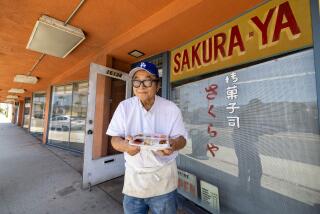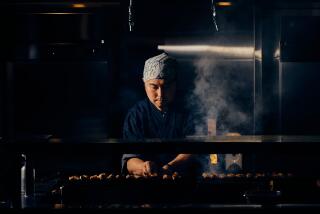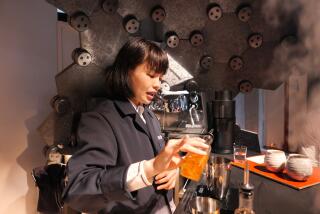Japanese Lacquerware: Fine Art of Perfection
WAJIMA, Japan — Most famous for its durable lacquerware bowls, tea cups and trays, this bustling market and fishing town faces the Sea of Japan from the scenic coast of the remote Noto Peninsula northwest of Tokyo.
There are various local legends about how the lacquerware craft came to Wajima. Some say it existed 1,000 years ago. Others attribute its arrival to an unnamed priest who moved here in the early 1400s and began making beautiful bowls using a locally harvested lacquer sap.
Wajima’s lacquerware industry was at its height during the Edo Period (1600 to 1867), but even today about one-third of the town of about 33,000 is connected with the lacquerware industry.
The industry has two branches. One continues to produce pieces the traditional way, by combining the talents of artists who specialize in one phase of the process and then pass the piece on after completing their part.
The other consists of individualists who work start to finish on a piece and give it their own personal style.
Visitors to Wajima should begin their lacquerware tour at the famous Wajima Shikki Shiryokan (or Wajima Lacquer Hall; admission, about $2), where it is possible to see demonstrations and fine examples of Wajima lacquerware--with its perfectly polished red or black surfaces.
The base of all Wajima lacquerware is locally harvested wood. Pieces turned out on a lathe are usually made from zelkova wood, which has a dense texture and obvious grain. Ate, a type of cypress, is also used.
A constant supply of aged and carefully shaped wooden forms is essential for production. Wajima artisans prefer to use forms made by local lathe workers so that they can guarantee the quality of the work from the start.
The lathe workers prepare the wood by cutting it into rough shapes, smoking it in a special cabinet and drying it for several months before putting it back on the lathe to give it a final form. The most challenging part is not the lathe work, but knowing when the wood is ready for its final shaping.
The next two stages of production involve reinforcement and are critical to the success of each piece. If they are not done perfectly, the piece will be badly flawed and unusable.
The first involves what makes Wajima lacquerware unique: Base wooden forms are reinforced by application of narrow strips of cloth with a thin coat of lacquer to parts that may be fragile or weak.
Next, locally mined clay is mixed with lacquer and glue to make a reinforcing compound that is applied to the surface of the base wood. This compound, which is harder than ordinary clay, permeates the wood, giving it strength and resistance.
After the cloth strips and lacquer are applied for reinforcement, coats of an intermediate, hard and dark lacquer are brushed on to the piece. Each layer is allowed to harden in a cool, humid area.
Following application of the intermediate lacquer, each piece is polished with special charcoal from Shizouka, near Mt. Fuji, and is checked for imperfections.
The final coat of lacquer must be applied in a dust-free environment to avoid a single speck from adhering to and ruining the flawless surface of the piece.
When the final coat has hardened, decorative motifs are applied with gold or silver leaf. Sometimes fine lines are cut into the lacquer surface and are filled with gold or silver leaf. These processes are another specialty. When they are complete, yet another specialist polishes each piece again and again, applying titanium powder to the surface with his hands.
Isaburo Kadoq is one of Wajima’s modern and inventive lacquerware artists. He experiments with application of lacquer with the fingers, leaving uneven surfaces that are polished until they look worn with age. In some pieces, he allows the grain of the wooden base to be visible through the lacquer surface.
There are several well-stocked lacquerware shops in Wajima. Wajimaya Honten (at 24-11 Kawai-machi) offers beautiful trays priced from $71 to $143, small plates from $375 to $714 per five-plate set, soup bowls for about $2,000 per five-bowl set, exquisite short-legged tables for about $7,000 to $14,000, and screens for $7,000 and up.
Inachu Shitsugei-do (at 3-1 Chuo-dori) trays sell for about $100, sets of five soup bowls are about $2,200, screens sell for $14,300 and up, and other furniture is priced from $3,500 to $35,000. Tea spoons and other tea ceremony accessories cost from $71.
Omukai Koshu-do (at 6-45 Futatsuya-machi) sells sets of five soup bowls for $71 and up per set, low tables from about $4,000 and sets of sake bottles and five cups for about $2,714 per set.
Isaburo Kado’s work appears at Wajima Shikki Shiryokan.
All of these shops are within walking distance of Wajima Station.
Prices quoted in this article reflect currency exchange rates at the time of writing.
More to Read
Sign up for The Wild
We’ll help you find the best places to hike, bike and run, as well as the perfect silent spots for meditation and yoga.
You may occasionally receive promotional content from the Los Angeles Times.






